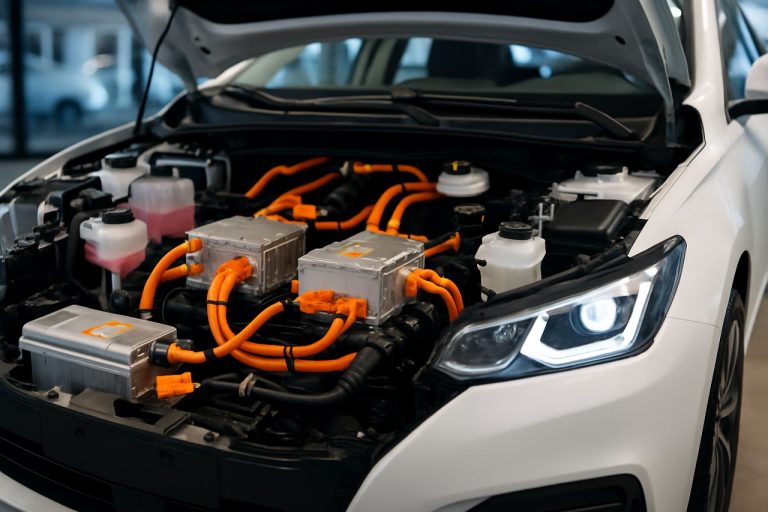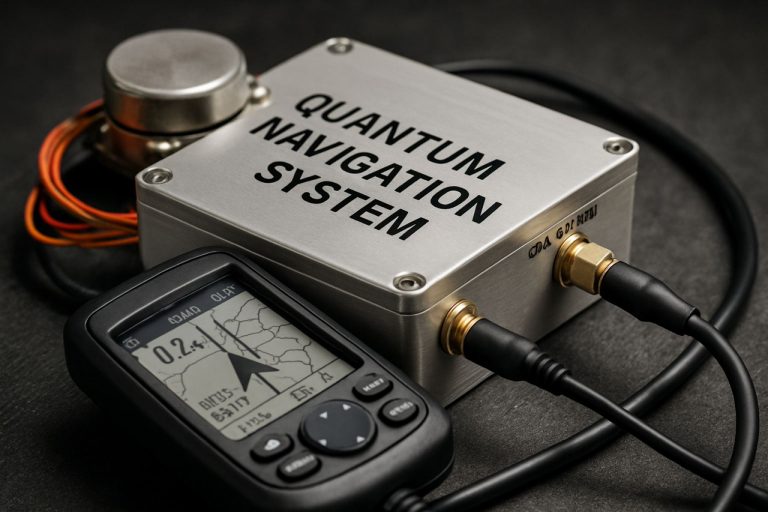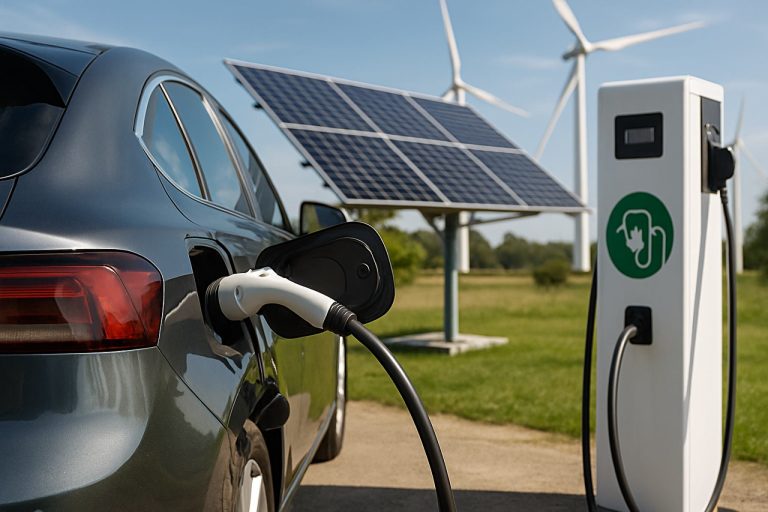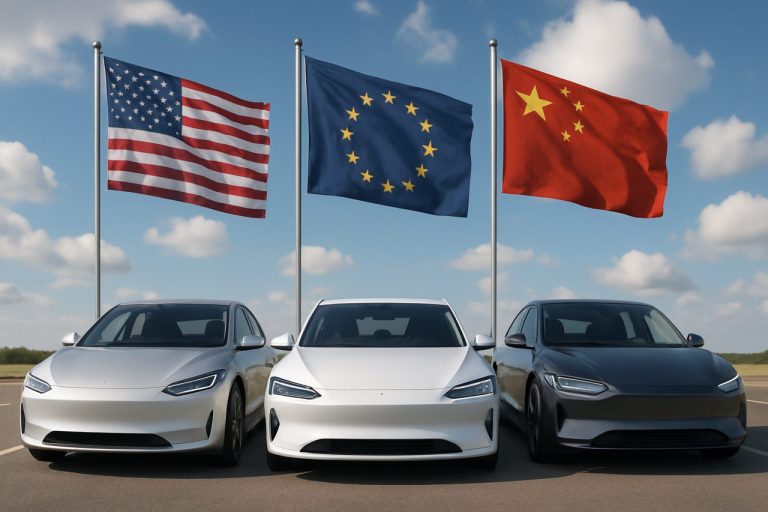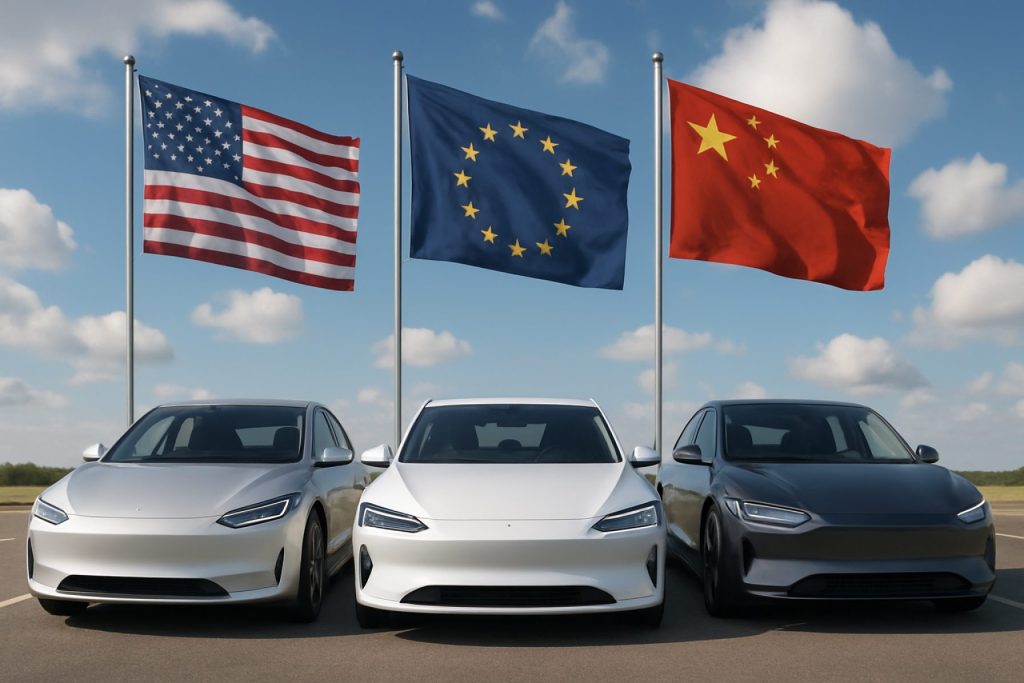
US, EU, and China Face Off in the 2025 EV Market: Unprecedented Competition, Rapid Innovation, and the Race for Global Leadership. Explore How Policy, Technology, and Market Forces Will Shape the Next Era of Electric Vehicles.
- Executive Summary: Key Findings and Market Growth Projections
- Global EV Market Size 2025–2030: US, EU, and China in Numbers
- Competitive Landscape: Major Players and Strategic Alliances
- Policy and Regulatory Drivers: Government Incentives and Trade Barriers
- Battery Technology Innovations: Solid-State, LFP, and Beyond
- Supply Chain Dynamics: Critical Minerals, Manufacturing, and Localization
- Charging Infrastructure: Expansion, Standards, and Interoperability
- Consumer Trends: Adoption Rates, Preferences, and Barriers
- Market Forecasts: CAGR and Volume Projections by Region (2025–2030)
- Future Outlook: Disruptive Technologies and the Path to Market Leadership
- Sources & References
Executive Summary: Key Findings and Market Growth Projections
The global electric vehicle (EV) market is entering a pivotal phase in 2025, marked by intensifying competition among the United States, European Union, and China. These three regions collectively account for the vast majority of global EV production, sales, and technological innovation. In 2024, China maintained its position as the world’s largest EV market, with over 8 million new energy vehicles sold, representing more than 60% of global EV sales. Leading Chinese manufacturers such as BYD Company Limited and Geely Automobile Holdings Limited have expanded their global reach, leveraging cost advantages and robust domestic supply chains.
The European Union remains the second-largest EV market, with strong policy support and ambitious emissions targets driving adoption. In 2024, the EU saw EV sales surpass 3 million units, with key players including Volkswagen AG, Stellantis N.V., and Renault Group accelerating electrification strategies. The EU’s regulatory environment, including the proposed 2035 ban on new internal combustion engine vehicles, is expected to further stimulate demand and investment in local battery manufacturing.
The United States, while trailing China and the EU in absolute sales, is experiencing rapid growth. In 2024, U.S. EV sales exceeded 1.4 million units, with Tesla, Inc. maintaining a dominant market share, followed by increased activity from legacy automakers such as Ford Motor Company and General Motors Company. The Inflation Reduction Act and related incentives are expected to accelerate domestic EV production and battery supply chain localization through 2025 and beyond.
Looking ahead, the competitive landscape is set to intensify. Chinese manufacturers are targeting overseas expansion, particularly in Europe, prompting the EU to consider trade measures and local content requirements. Meanwhile, U.S. and European automakers are investing heavily in next-generation battery technologies and charging infrastructure to close the cost and performance gap with Chinese rivals. By 2027, global EV sales are projected to exceed 20 million units annually, with the US, EU, and China accounting for over 85% of this volume. The interplay of industrial policy, technological innovation, and cross-border trade dynamics will shape the trajectory of the EV market over the next several years.
Global EV Market Size 2025–2030: US, EU, and China in Numbers
The global electric vehicle (EV) market is entering a pivotal phase between 2025 and 2030, with the United States, European Union, and China vying for leadership in production, sales, and technological innovation. In 2025, China is projected to maintain its dominant position, accounting for over half of global EV sales. According to SAIC Motor Corporation—one of China’s largest automakers—China’s domestic EV sales surpassed 8 million units in 2023, and the market is expected to exceed 10 million units annually by 2025. Major Chinese manufacturers such as BYD Company and Geely Holding Group are expanding aggressively, both domestically and in export markets, leveraging cost advantages and a robust supply chain.
In the European Union, the EV market is set for rapid growth, driven by stringent emissions regulations and ambitious electrification targets. The European Automobile Manufacturers’ Association (ACEA) reports that EVs represented over 20% of new car registrations in the EU in 2023, with projections indicating a rise to 30–35% by 2025. Leading European automakers such as Volkswagen AG, Stellantis N.V., and BMW Group are investing heavily in new EV models and battery production facilities to meet demand and comply with regulatory requirements.
The United States is also accelerating its EV transition, supported by federal incentives and infrastructure investments. Tesla, Inc. remains the market leader, but traditional automakers like Ford Motor Company and General Motors Company are scaling up EV production. The U.S. Department of Energy projects that EVs could account for 20–25% of new vehicle sales in the U.S. by 2025, with annual sales potentially reaching 3–4 million units.
Looking ahead to 2030, the competitive landscape is expected to intensify. China’s established manufacturing base and cost leadership position it as a formidable global exporter, while the EU’s regulatory push and the U.S.’s innovation ecosystem are driving rapid adoption and technological advances. Battery supply chains, charging infrastructure, and cross-border trade policies will be critical factors shaping market shares. The interplay between these regions will define the trajectory of the global EV market, with each leveraging its unique strengths to capture a larger share of the rapidly expanding sector.
Competitive Landscape: Major Players and Strategic Alliances
The global electric vehicle (EV) market in 2025 is defined by intense competition among major players from the United States, European Union, and China, each leveraging unique strengths and strategic alliances to secure market share. The competitive landscape is shaped by established automakers, innovative startups, and cross-border partnerships, all vying for leadership in technology, production capacity, and market reach.
In the United States, Tesla, Inc. remains the dominant EV manufacturer, with a robust production footprint and a strong brand presence both domestically and internationally. Tesla’s Gigafactories in the US, China, and Europe enable it to scale production and respond to regional demand fluctuations. The company continues to invest in battery technology and software, maintaining a competitive edge in range and autonomous driving features. Other US automakers, such as General Motors Company and Ford Motor Company, are accelerating their EV strategies, launching new models and forming alliances for battery supply and charging infrastructure.
The European Union’s EV market is characterized by a diverse set of players, including legacy manufacturers like Volkswagen AG, Stellantis N.V., and Mercedes-Benz Group AG. These companies are rapidly electrifying their fleets, investing in dedicated EV platforms, and forming joint ventures for battery production and recycling. For example, Volkswagen’s partnerships with battery suppliers and its expansion of the “PowerCo” battery business are central to its strategy. European automakers are also collaborating on charging networks, such as the IONITY joint venture, to address infrastructure gaps and enhance customer adoption.
China’s EV sector is led by companies like BYD Company Limited, NIO Inc., and Zhejiang Geely Holding Group Co., Ltd.. These firms benefit from strong government support, advanced battery supply chains, and a large domestic market. BYD, in particular, has become a global force, expanding exports to Europe and Latin America and establishing overseas manufacturing facilities. Chinese automakers are also forming alliances with international partners for technology sharing and market entry, as seen in joint ventures and supply agreements with European and Southeast Asian companies.
Strategic alliances are increasingly important as automakers seek to secure battery materials, develop next-generation technologies, and navigate regulatory environments. Cross-border collaborations—such as US and European firms partnering with Asian battery manufacturers, or Chinese companies investing in European assembly plants—are expected to intensify through 2025 and beyond. The competitive landscape will continue to evolve as new entrants emerge, established players adapt, and governments adjust policies in response to shifting market dynamics.
Policy and Regulatory Drivers: Government Incentives and Trade Barriers
Government policy and regulatory frameworks are central to shaping the competitive landscape of the electric vehicle (EV) market among the United States, European Union, and China. In 2025, these regions are intensifying their use of incentives, subsidies, and trade barriers to bolster domestic industries and manage foreign competition.
The United States has expanded its EV policy toolkit under the Inflation Reduction Act, which provides tax credits of up to $7,500 for qualifying EVs assembled in North America and with a significant portion of battery components sourced domestically or from free-trade partners. This policy aims to stimulate domestic manufacturing and reduce reliance on Chinese supply chains. The U.S. has also imposed tariffs on Chinese EVs and batteries, with the Biden administration announcing in 2024 a quadrupling of tariffs on Chinese EV imports to 100%, citing concerns over market distortion and national security (Tesla, Inc.).
The European Union, meanwhile, has historically supported EV adoption through generous purchase incentives and emissions regulations. However, in 2024-2025, the EU has shifted focus toward protecting its automotive sector from what it deems unfair competition. The European Commission launched an anti-subsidy investigation into Chinese EV imports, and in 2025, provisional tariffs on Chinese-made EVs are expected to be implemented. These measures are designed to counteract the impact of Chinese state subsidies and maintain a level playing field for European manufacturers such as Volkswagen AG and Stellantis N.V..
China, the world’s largest EV market and home to leading manufacturers like BYD Company Limited and Zhejiang Geely Holding Group, continues to support its domestic industry through a mix of direct subsidies, tax exemptions, and non-monetary incentives such as license plate privileges in major cities. While some direct subsidies have been phased out, local governments and state-owned enterprises still provide significant support for R&D, infrastructure, and market expansion. China has also responded to foreign tariffs with its own trade measures and is actively seeking to diversify export markets, particularly in Southeast Asia and Latin America.
Looking ahead, the interplay of incentives and trade barriers is likely to intensify. The U.S. and EU are expected to maintain or escalate protectionist measures, while China will continue to leverage its scale and supply chain advantages. This policy-driven competition will shape global EV supply chains, investment flows, and the pace of technological innovation through at least the late 2020s.
Battery Technology Innovations: Solid-State, LFP, and Beyond
The competition among the US, EU, and China in the electric vehicle (EV) market is increasingly defined by rapid advancements in battery technology, particularly in solid-state batteries, lithium iron phosphate (LFP), and next-generation chemistries. As of 2025, these innovations are shaping not only vehicle performance and cost but also the strategic positioning of automakers and battery suppliers across these major regions.
China continues to dominate global battery manufacturing, accounting for over 70% of the world’s lithium-ion battery production capacity. Leading Chinese companies such as Contemporary Amperex Technology Co., Limited (CATL) and BYD Company Limited have aggressively scaled up LFP battery production, which offers cost advantages, improved safety, and longer cycle life compared to traditional nickel-manganese-cobalt (NMC) chemistries. In 2024, CATL introduced its “Shenxing” LFP battery, capable of ultra-fast charging and extended range, and is supplying both domestic and international automakers. BYD, meanwhile, has integrated its proprietary “Blade Battery” into its expanding EV lineup and is exporting battery packs to global partners.
In the US, the focus is on both scaling domestic battery manufacturing and accelerating the commercialization of solid-state batteries. Ford Motor Company and General Motors Company have announced partnerships and investments in solid-state battery startups, aiming for higher energy density and improved safety. QuantumScape Corporation, a leading US-based solid-state battery developer, is targeting commercial production in the latter half of the decade, with pilot lines and automotive testing underway in 2025. The US government’s Inflation Reduction Act is also incentivizing local battery production and supply chain development, aiming to reduce reliance on Asian imports.
The European Union is prioritizing battery innovation and supply chain resilience through initiatives such as the European Battery Alliance. Companies like Northvolt AB are ramping up production of both NMC and LFP batteries, with plans to introduce solid-state cells in collaboration with automotive partners. Major automakers including Volkswagen AG and Stellantis N.V. are investing in in-house battery R&D and joint ventures to secure next-generation cell technologies.
Looking ahead, the race to commercialize solid-state batteries is expected to intensify, with pilot production and limited deployment likely by 2026–2027. LFP batteries will remain a key technology for mass-market EVs, especially in China and increasingly in Western markets. The interplay between regional policy, supply chain localization, and technological breakthroughs will continue to define the competitive landscape among the US, EU, and China in the global EV market.
Supply Chain Dynamics: Critical Minerals, Manufacturing, and Localization
The competition among the US, EU, and China in the electric vehicle (EV) market is increasingly shaped by supply chain dynamics, particularly regarding critical minerals, manufacturing capacity, and localization strategies. As of 2025, these regions are intensifying efforts to secure access to essential raw materials, expand domestic manufacturing, and localize supply chains to reduce dependencies and enhance competitiveness.
China remains the dominant force in the global EV supply chain, controlling a significant share of the world’s processing capacity for critical minerals such as lithium, cobalt, and rare earth elements. Chinese companies like Contemporary Amperex Technology Co. Limited (CATL) and BYD Company Limited are not only leading battery manufacturers but also have extensive upstream integration, securing raw material sources and refining capabilities. According to industry data, China processes over 60% of the world’s lithium and over 70% of cobalt, underpinning its battery and EV manufacturing dominance.
In response, the United States has accelerated efforts to localize its EV supply chain. The Inflation Reduction Act (IRA) incentivizes domestic production of batteries and vehicles, as well as sourcing of critical minerals from either the US or allied countries. Major US automakers such as General Motors and Ford Motor Company have announced multi-billion-dollar investments in new battery plants and partnerships with mineral suppliers. For example, General Motors is collaborating with domestic and international partners to secure lithium and nickel supplies, while Ford is investing in battery manufacturing facilities in the US and Canada. These moves aim to meet both regulatory requirements and growing consumer demand for EVs.
The European Union is also prioritizing supply chain resilience and localization. The European Battery Alliance, supported by the European Commission, seeks to establish a competitive battery value chain within Europe. Companies such as Volkswagen AG and Northvolt AB are investing in gigafactories and forming partnerships to secure sustainable supplies of lithium, nickel, and cobalt. The EU’s Critical Raw Materials Act, effective from 2025, sets ambitious targets for domestic sourcing and processing, aiming to reduce reliance on imports from China and other non-EU countries.
Looking ahead, the next few years will likely see intensified competition as each region seeks to secure critical mineral supplies, scale up manufacturing, and localize supply chains. The success of these strategies will be pivotal in determining market leadership, cost competitiveness, and the ability to meet ambitious EV adoption targets set for 2030 and beyond.
Charging Infrastructure: Expansion, Standards, and Interoperability
The rapid expansion of electric vehicle (EV) charging infrastructure is a critical battleground in the ongoing competition between the US, EU, and China. As of 2025, each region is pursuing aggressive strategies to scale up charging networks, set technical standards, and ensure interoperability, all of which are essential for mass EV adoption and market leadership.
China remains the global leader in public charging infrastructure, with over 2.7 million public charging points installed by early 2025. The country’s state-backed approach, led by major players such as State Grid Corporation of China and TELD New Energy, has enabled rapid deployment of both fast and slow chargers across urban and rural areas. China’s government mandates interoperability through national standards (GB/T), and is actively piloting ultra-fast charging and battery swap stations, with companies like NIO operating thousands of automated swap stations nationwide.
The European Union is accelerating its own infrastructure buildout, targeting at least 1 million public charging points by 2025, with a focus on high-power DC fast charging along major corridors. The EU’s European Automobile Manufacturers’ Association and the IONITY joint venture (backed by BMW, Mercedes-Benz, Ford, Hyundai, and Volkswagen Group) are central to this effort. The EU’s Alternative Fuels Infrastructure Regulation (AFIR) enforces minimum coverage and mandates the use of the Combined Charging System (CCS) standard for interoperability. Cross-border roaming and unified payment systems are being rolled out to ensure seamless user experience across member states.
In the United States, the federal government’s National Electric Vehicle Infrastructure (NEVI) program is investing billions to deploy at least 500,000 public chargers by 2026, with a strong emphasis on fast charging along highways and in underserved communities. Major US charging network operators include Tesla (with its Supercharger network), ChargePoint Holdings, and EVgo. A significant shift is underway as Tesla opens its North American Charging Standard (NACS) to other automakers, with Ford, General Motors, and others announcing adoption of NACS connectors for new vehicles from 2025 onward. This move is expected to drive greater interoperability and may influence future standardization in North America.
Looking ahead, the competition will intensify as each region seeks to address remaining challenges: grid integration, rural coverage, and harmonization of payment and authentication systems. The convergence of standards—such as the growing global influence of CCS and NACS—will be pivotal. The next few years will likely see increased cross-border collaborations, technology sharing, and policy-driven incentives, as the US, EU, and China vie for leadership in the global EV ecosystem.
Consumer Trends: Adoption Rates, Preferences, and Barriers
The electric vehicle (EV) market in the US, EU, and China is experiencing rapid evolution in 2025, with consumer trends reflecting both regional preferences and global shifts. Adoption rates continue to diverge, shaped by government incentives, infrastructure development, and the availability of diverse EV models.
China remains the global leader in EV adoption, with over 30% of new car sales being electric as of early 2025. This dominance is driven by a combination of robust government support, extensive charging infrastructure, and a wide range of affordable models from domestic manufacturers such as BYD Company Limited, Geely Automobile Holdings, and SAIC Motor Corporation. Chinese consumers show a strong preference for compact and mid-sized EVs, with increasing interest in smart connectivity and advanced driver-assistance features. The rapid rollout of battery-swapping stations and urban charging networks further reduces range anxiety, a key barrier in other regions.
In the European Union, EV adoption rates are also climbing, with several countries—such as Norway, Germany, and the Netherlands—reporting EVs accounting for 20–40% of new vehicle sales. The EU’s regulatory environment, including stringent CO2 targets and incentives for zero-emission vehicles, has accelerated consumer uptake. European buyers tend to favor premium and mid-sized EVs, with brands like Volkswagen AG, Bayerische Motoren Werke AG (BMW Group), and Stellantis N.V. expanding their electric lineups. However, high upfront costs and uneven charging infrastructure—especially in Southern and Eastern Europe—remain significant barriers.
The United States lags behind China and the EU in EV market share, with electric vehicles comprising around 10–12% of new car sales in 2025. Consumer preferences skew toward larger vehicles, such as SUVs and pickup trucks, prompting manufacturers like Ford Motor Company, General Motors Company, and Tesla, Inc. to prioritize these segments. While federal and state incentives have spurred growth, concerns about charging availability, range, and vehicle price persist, particularly outside major urban centers.
Looking ahead, all three regions are expected to see continued growth in EV adoption, but at varying paces. China’s market is projected to maintain its lead, bolstered by ongoing innovation and cost reductions. The EU’s trajectory will depend on infrastructure expansion and policy consistency, while the US market’s growth hinges on overcoming consumer hesitancy and scaling domestic manufacturing. Across all regions, consumer demand for longer range, faster charging, and lower prices will shape the competitive landscape through the remainder of the decade.
Market Forecasts: CAGR and Volume Projections by Region (2025–2030)
The global electric vehicle (EV) market is entering a pivotal phase between 2025 and 2030, with the United States, European Union, and China vying for leadership in both production and adoption. Each region is leveraging its industrial base, policy frameworks, and technological advancements to capture a larger share of the rapidly expanding EV sector.
China remains the dominant force in EV manufacturing and sales, accounting for over half of global EV deliveries in 2024. Projections for 2025–2030 suggest China will maintain a compound annual growth rate (CAGR) of approximately 15–20%, with annual EV sales expected to surpass 15 million units by 2030. This growth is underpinned by the expansive production capabilities of companies such as BYD Company Limited, which has become the world’s largest EV manufacturer, and Geely Holding Group, a major player with global ambitions. The Chinese government’s continued support for electrification, including incentives and infrastructure investment, further solidifies the country’s leadership position.
The European Union is projected to see a robust CAGR of 18–22% in EV sales through 2030, driven by stringent emissions regulations and the 2035 ban on new internal combustion engine vehicles. Major automakers such as Volkswagen AG, Stellantis N.V., and Renault Group are accelerating their electrification strategies, with significant investments in battery production and new EV models. By 2030, annual EV sales in the EU are forecast to reach 10–12 million units, with the region aiming for a 60–70% EV share of new car sales. The EU’s focus on building a domestic battery supply chain, led by initiatives from companies like Northvolt AB, is expected to reduce reliance on imports and enhance competitiveness.
In the United States, the EV market is poised for a CAGR of 20–25% through 2030, spurred by federal incentives, state-level mandates, and major investments from automakers such as Tesla, Inc., Ford Motor Company, and General Motors Company. The U.S. aims to achieve 50% EV share of new vehicle sales by 2030, translating to an estimated 7–8 million annual EV sales. The expansion of domestic battery manufacturing, led by companies like Panasonic Holdings Corporation (with U.S. gigafactories), is expected to support this growth and reduce supply chain vulnerabilities.
Overall, the 2025–2030 period will see intensifying competition among the US, EU, and China, with each region leveraging its unique strengths. While China is likely to retain its lead in volume, the EU and US are expected to close the gap through aggressive policy measures, technological innovation, and strategic investments in local supply chains.
Future Outlook: Disruptive Technologies and the Path to Market Leadership
The competition among the United States, European Union, and China in the electric vehicle (EV) market is intensifying as each region pursues technological leadership and market dominance. As of 2025, the global EV landscape is shaped by rapid innovation in battery technology, software integration, and supply chain localization, with each bloc leveraging its unique strengths and industrial policies to secure a competitive edge.
China remains the world’s largest EV market, accounting for over half of global EV sales. Leading Chinese manufacturers such as BYD Company Limited and Geely Automobile Holdings have aggressively expanded their product portfolios, focusing on affordable models and advanced battery chemistries like lithium iron phosphate (LFP). Contemporary Amperex Technology Co. Limited (CATL), the world’s largest battery supplier, continues to drive innovation with high-nickel and sodium-ion batteries, aiming to reduce costs and improve energy density. Chinese automakers are also accelerating exports, targeting both emerging and developed markets, and investing in overseas manufacturing to circumvent trade barriers.
The European Union is responding with robust policy measures and investments in domestic battery production and EV manufacturing. The Volkswagen Group and Stellantis N.V. are scaling up gigafactory projects and introducing new EV platforms, while BMW Group and Mercedes-Benz Group AG are integrating next-generation battery technologies and advanced driver-assistance systems. The EU’s regulatory framework, including stricter CO₂ emission targets and incentives for local sourcing, is designed to foster innovation and reduce reliance on Asian battery suppliers. European battery manufacturers such as Northvolt AB are scaling up production, aiming to supply both domestic and international automakers.
In the United States, the Inflation Reduction Act and other federal initiatives are catalyzing investment in domestic EV and battery supply chains. Tesla, Inc. continues to lead in both vehicle and battery innovation, with ongoing development of 4680 battery cells and expansion of manufacturing capacity. Traditional automakers like General Motors Company and Ford Motor Company are accelerating electrification plans, launching new EV models and forming joint ventures for battery production. The U.S. is also investing in next-generation technologies such as solid-state batteries and advanced power electronics, aiming to close the gap with Asian competitors.
Looking ahead, the race for market leadership will hinge on breakthroughs in battery technology, software-defined vehicles, and resilient supply chains. Strategic partnerships, government support, and the ability to scale disruptive innovations will determine which region sets the pace in the global EV transition through the late 2020s.
Sources & References
- BYD Company Limited
- Geely Automobile Holdings Limited
- Volkswagen AG
- Stellantis N.V.
- Renault Group
- General Motors Company
- ACEA
- General Motors Company
- Ford Motor Company
- Volkswagen AG
- Stellantis N.V.
- BYD Company Limited
- Contemporary Amperex Technology Co., Limited (CATL)
- QuantumScape Corporation
- Northvolt AB
- IONITY
- ChargePoint Holdings
- EVgo
